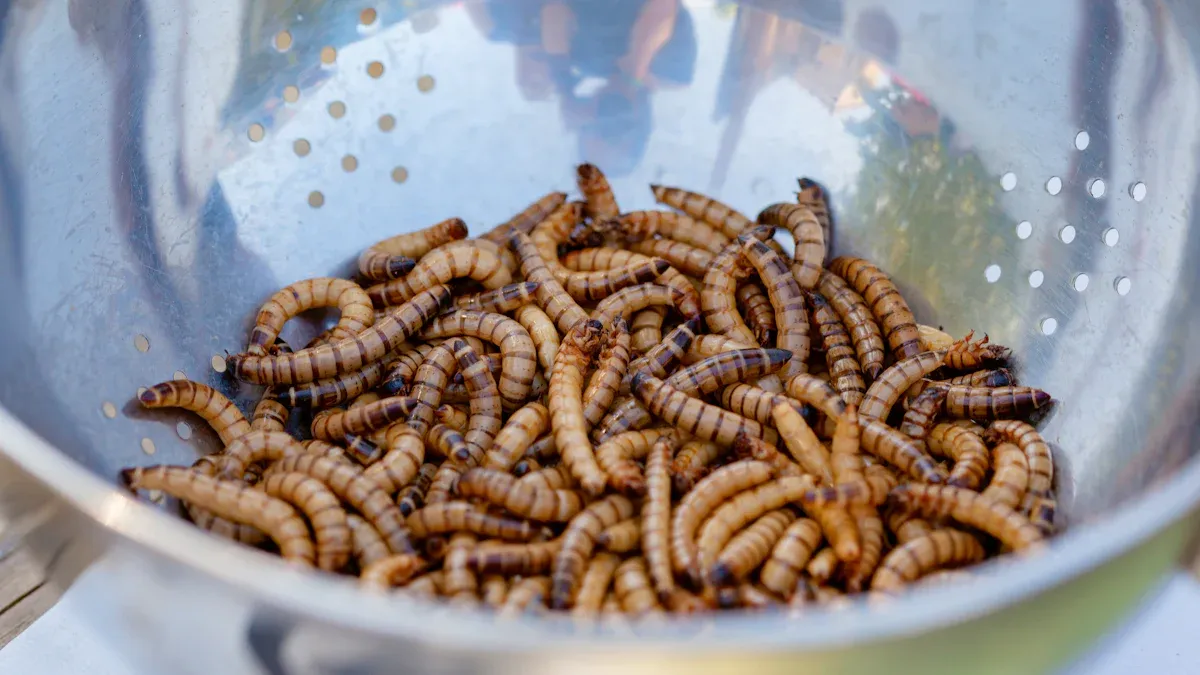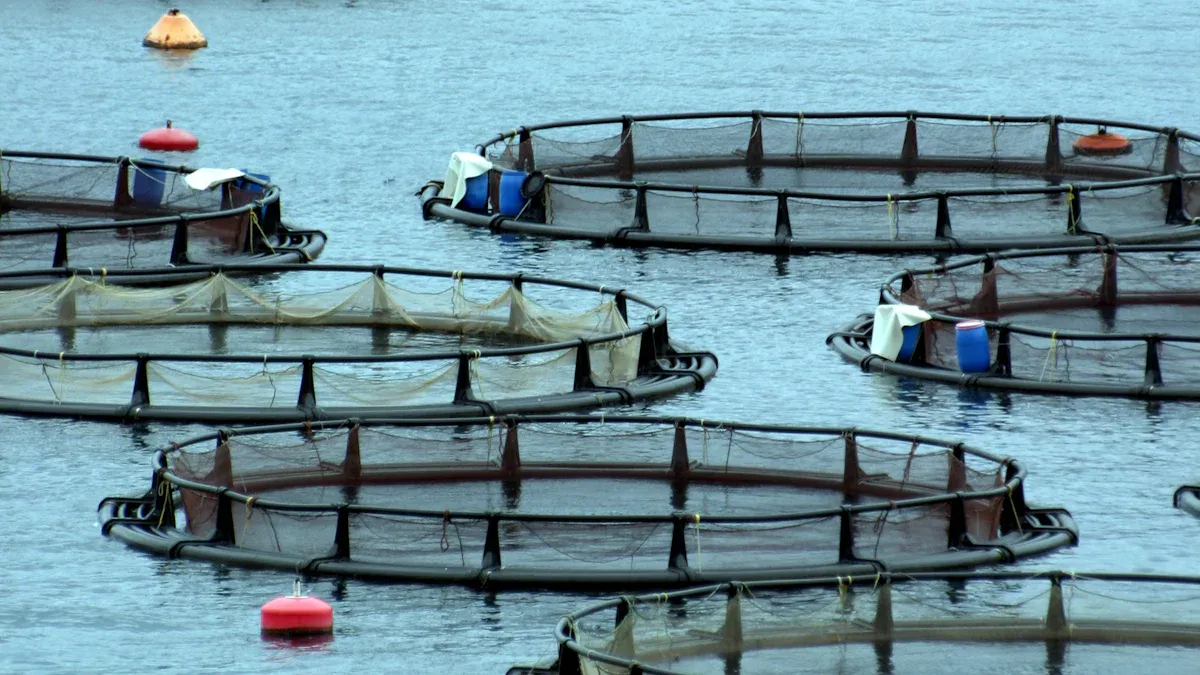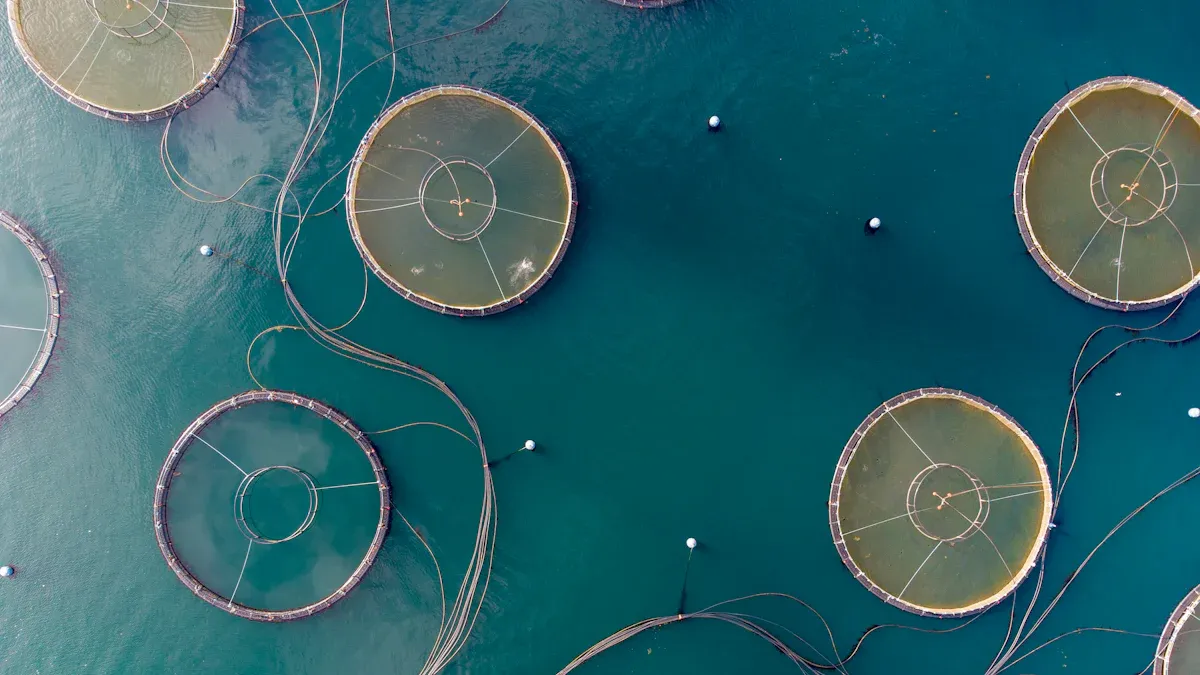
Aquaculture is turning to innovative solutions, and dried mealworms are leading the charge. They deliver sustainability, high nutritional value, and cost-effectiveness. For instance:
- Yellow mealworms thrive on wheat bran with a survival rate of 95%.
- Mealworms need 10 times less land and 20 times less water than beef.
These advantages make dried mealworms for aquaculture a game-changer.
Key Takeaways
- Dried mealworms are an eco-friendly option for fish food. They need much less land and water than raising cows.
- Adding dried mealworms to fish food helps them grow faster. It also makes fish healthier and improves their immune systems.
- Using mealworms lowers harm to the environment. They turn food waste into useful protein, helping the planet.
Challenges in Traditional Aquaculture Feed
Overreliance on Fishmeal and Fish Oil
The aquaculture industry has leaned heavily on fishmeal and fish oil for decades. These ingredients, derived from wild-caught fish, remain a cornerstone of traditional feed. However, this reliance comes with challenges.
- The global fish production used for non-food purposes dropped from 30% in the 1990s to about 12% in 2016.
- Despite this decline, aquaculture still consumes around 20 million tons annually for fishmeal and oil.
This dependency strains marine ecosystems and raises concerns about long-term sustainability. As fish stocks dwindle, the industry faces mounting pressure to find alternatives that reduce its environmental impact.
Environmental and Economic Concerns
Traditional feed ingredients like fishmeal and fish oil aren’t just costly—they’re also linked to environmental degradation. Overfishing to meet feed demands disrupts marine biodiversity and threatens the balance of aquatic ecosystems.
On the economic side, fluctuating fishmeal prices create uncertainty for fish farmers. Rising costs can make aquaculture less profitable, especially for small-scale operations. These challenges highlight the need for feed solutions that are both affordable and eco-friendly.
Rising Demand for Sustainable Alternatives
The push for sustainable aquaculture practices has sparked innovation in feed development. Companies are exploring new ingredients and technologies to meet this demand.
| Evidence Type | Description |
|---|---|
| Product Innovation | BioMar introduced feed formulas with bioactive peptides to boost disease resistance. |
| Adoption Rate | A 15% increase in functional feed adoption over three years has improved fish survival rates. |
| Ingredient Innovation | Algae-based omega-3 fatty acids offer a greener substitute for traditional fish oil. |
Advancements like probiotics, prebiotics, and algae-based nutrients are reshaping the industry. These innovations not only enhance fish health but also reduce environmental waste, paving the way for a more sustainable future.
Nutritional Benefits of Dried Mealworms for Aquaculture

High Protein Content and Essential Nutrients
Dried mealworms are packed with nutrients that make them an excellent choice for aquaculture feed. Their high protein content, ranging from 13.68 to 22.32 grams per 100 grams, supports the growth and development of fish. Alongside protein, they contain essential amino acids, which are vital for building and repairing tissues in aquatic species.
But that’s not all. These tiny insects are also rich in vitamins and minerals. They provide high levels of riboflavin, pyridoxine, folate, and vitamin B12, all of which play a crucial role in metabolic processes and immune function. Minerals like zinc and magnesium contribute to bone health and enzymatic activities, ensuring fish stay healthy and thrive.
Here’s a quick breakdown of their nutritional profile:
| Nutrient | Content (per 100g) |
|---|---|
| Protein | 13.68–22.32 g |
| Fat | 8.90–19.94 g |
| Polyunsaturated Fatty Acids | Present |
| Zinc | High |
| Magnesium | High |
| Calcium | Low |
| Niacin | Present |
| Pyridoxine | High |
| Riboflavin | High |
| Folate | High |
| Vitamin B12 | High |
| Essential Amino Acids | Present |
This nutrient-dense profile makes dried mealworms for aquaculture a superior alternative to many traditional feed options.
Improved Fish Growth and Health
Feeding fish with dried mealworms doesn’t just provide nutrients—it also enhances their growth and overall health. Studies have shown that including mealworms in fish diets significantly improves weight gain and specific growth rates. For example, an 8-week feeding trial with rainbow trout revealed that mealworm-based diets led to better growth performance compared to traditional feeds.
Fish fed with mealworms also displayed a higher protein efficiency ratio and a lower feed conversion ratio. This means they utilized the feed more effectively, resulting in less waste and better growth. Additionally, mealworms boost immune responses in fish. Increased myeloperoxidase and lysozyme activities were observed, which are indicators of a stronger immune system.
Did you know? A dietary inclusion level of just 14% mealworms can lead to noticeable improvements in fish performance.
By improving both growth and health, dried mealworms for aquaculture offer a win-win solution for fish farmers.
Comparison with Traditional Feed Ingredients
When compared to traditional feed ingredients like fishmeal, dried mealworms stand out in several ways. They provide similar or even higher levels of protein and fat, which are crucial for fish growth. However, mealworms also offer additional benefits, such as a richer supply of vitamins and minerals.
Here’s a comparison of nutritional components:
| Nutritional Component | Mealworms (with potato cuttings) | Control Feed (agar) | Vegetable Mix | Horticultural Foliage |
|---|---|---|---|---|
| Protein Content | Similar | Similar | Higher | Higher |
| Fat Content | Doubled | N/A | Higher | N/A |
| Carbohydrate Content | Comparable | Comparable | Lower | N/A |
| Crude Ash | Increased | N/A | Higher | N/A |
| Non-fiber Carbohydrates | Decreased | N/A | N/A | N/A |
| Dry Matter Content | Higher | Lower | Lower | Lower |
This table highlights how mealworms outperform many traditional feed options in terms of fat and dry matter content. These advantages, combined with their sustainability, make them a game-changer in aquaculture feed.
Economic and Environmental Advantages
Cost-Effectiveness and Scalability
Dried mealworms are proving to be a cost-effective solution for aquaculture feed. Their high protein content, reaching up to 55%, makes them a sustainable alternative to traditional feed ingredients like fishmeal and soybean meal. Unlike fishmeal, which is subject to price fluctuations, mealworms offer consistent affordability. Companies like Ynsect and Protix have scaled production using industrial dryers, demonstrating their ability to meet growing demand.
The scalability of dried mealworms is another major advantage. Industrial farming techniques allow for efficient production, ensuring a steady supply for aquaculture, poultry, and livestock farming. As the market for insect-based proteins expands, mealworms are becoming a reliable option for fish farmers seeking both nutritional benefits and economic stability.
Reduced Environmental Footprint
Switching to dried mealworms for aquaculture significantly reduces the environmental impact of fish farming. Producing mealworms requires only 4341 m³ of water per ton, which is far less than beef and comparable to chicken. Their carbon footprint is also minimal, with just 20.4 kg CO2-eq emitted per kilogram of protein.
🌱 Tip: Lower ammonia emissions from mealworm farming contribute to cleaner air, making them an eco-friendly choice for sustainable aquaculture practices.
These advantages make dried mealworms a greener alternative to traditional feeds, helping fish farmers reduce their ecological footprint while maintaining high-quality production.
Contribution to Circular Economy and Waste Reduction
Dried mealworms play a key role in promoting a circular economy. They can bioconvert organic waste and even plastic materials, turning low-value substrates into valuable resources. This process produces protein biomass and biopolymers, which can be used in food, fertilizers, and other applications.
Mealworms enhance resource efficiency by utilizing waste that would otherwise go unused. By incorporating them into aquaculture feed, fish farmers contribute to waste reduction and support sustainable practices.
♻️ Note: Mealworms are not just feed—they’re a solution to global waste challenges, making them a powerful tool for eco-conscious aquaculture.
Practical Applications in Aquaculture

How Dried Mealworms Are Incorporated into Feed
Dried mealworms are versatile and easy to integrate into aquaculture feed. Farmers typically grind them into a fine powder or meal, which is then mixed with other feed ingredients. This process ensures that fish receive a balanced diet while benefiting from the high protein and nutrient content of mealworms.
Some feed manufacturers also use dried mealworms as a direct replacement for fishmeal. By doing so, they reduce reliance on traditional feed sources without compromising the nutritional quality of the feed. The adaptability of dried mealworms makes them suitable for various fish species, including trout, tilapia, and carp.
🐟 Tip: To maximize the benefits, farmers can experiment with different inclusion levels of dried mealworms in their feed formulations. Studies suggest that even a small percentage can significantly improve fish growth and health.
Case Studies of Successful Implementation
Several fish farming operations have successfully adopted dried mealworms as part of their feed strategy. For example, a trout farm in Europe replaced 25% of its fishmeal with dried mealworm powder. The results were impressive. The fish showed improved growth rates and better feed conversion efficiency.
Another case involved tilapia farming in Southeast Asia. Farmers incorporated dried mealworms into their feed to reduce costs. They reported not only financial savings but also healthier fish with vibrant coloration. These examples highlight the practical benefits of using dried mealworms for aquaculture.
🌱 Note: The success of these implementations demonstrates the potential of dried mealworms to revolutionize aquaculture feed practices.
Positive Impact on Fish Farming Operations
Using dried mealworms for aquaculture has a noticeable impact on fish farming operations. Farmers benefit from reduced feed costs, improved fish health, and higher yields. Additionally, the environmental advantages of mealworms, such as their low carbon footprint, align with the growing demand for sustainable aquaculture practices.
A study found that replacing fishmeal with yellow mealworm larvae meal did not negatively impact the gut and skin microbiota of rainbow trout. It showed only slight changes in microbiota composition, indicating that dried mealworms can be a valid alternative protein source in aquafeeds.
This finding reassures farmers that mealworms are a safe and effective option for their operations. By adopting this innovative feed ingredient, fish farmers can enhance productivity while contributing to a more sustainable future.
Market Trends and Consumer Acceptance
Growing Demand for Sustainable Aquaculture Practices
Sustainability is no longer just a buzzword—it’s a driving force in aquaculture. Consumers today want seafood that’s not only high-quality but also produced with minimal environmental impact. Certifications like ASC (Aquaculture Stewardship Council) and MSC (Marine Stewardship Council) have become essential for building trust. Transparency in the supply chain is another key factor. People want to know where their seafood comes from and how it’s produced.
The numbers tell the story. The global aquaculture market is expected to grow from $311.1 billion in 2023 to $573.7 billion by 2035, with a CAGR of 5.2%. This growth reflects the rising demand for sustainable practices. Plant-based alternatives, like brown seaweeds, are also gaining popularity, growing at a CAGR of 5.6%. Innovative techniques, such as integrated multi-trophic aquaculture (IMTA), are reshaping the industry by promoting ecological balance.
Regulatory Support for Insect-Based Feeds
Governments worldwide are stepping up to support insect-based feeds. In the European Union, Regulation (EU) 2017/893 allows processed animal protein from seven insect species in aquaculture feeds. Another regulation, (EU) 2021/1372, expanded this to include poultry and pig feed. Singapore has also embraced alternative proteins, offering R&D grants and creating a regulatory framework to encourage innovation.
These policies are paving the way for wider adoption of insect-based feeds. They ensure safety, promote sustainability, and encourage farmers to explore eco-friendly options like dried mealworms.
| Regulation | Description |
|---|---|
| Regulation (EU) 2017/893 | Permits processed animal protein from seven insect species in aquaculture. |
| Regulation (EU) 2021/1372 | Authorizes insect proteins in poultry and pig feed. |
| Singapore’s Framework | Supports alternative proteins with R&D grants and regulatory reviews. |
Increasing Consumer Awareness and Acceptance
Consumers are warming up to the idea of insects in aquaculture. Surveys show that over 70% of participants find insect-based feeds acceptable for farmed animals. In Europe, 90% of respondents expressed a positive attitude toward using insects as feed.
This shift in perception is driving market growth. The global insect-for-feed market is projected to grow at a CAGR of 14.78%, reaching $12 billion by 2032. People are recognizing the environmental benefits of insect farming, such as reduced waste and lower carbon emissions. As awareness grows, so does acceptance, making insect-based feeds a promising solution for sustainable aquaculture.
Dried mealworms for aquaculture provide a sustainable and nutrient-rich alternative to traditional feeds. Their versatility and cost-effectiveness make them a practical choice for fish farmers. As eco-friendly practices gain momentum, these tiny insects are poised to transform the aquaculture industry, ensuring a greener and more efficient future for fish farming.

